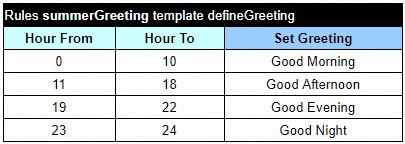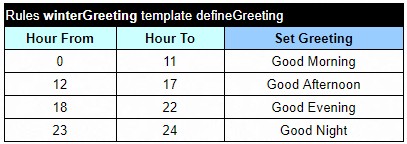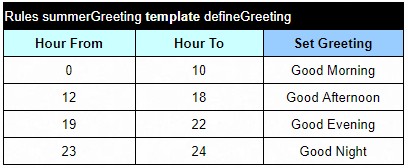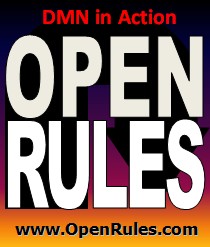Open Your Business Rules!
Rules-based
Operational Decision Services
OpenRules Classic: Rules Templates
Powerful templatization mechanism
- Simple rule templates
- Default rules inside templates
- Partial template implementation
- Optional conditions and actions
- Benefits
OpenRules Templates provide a powerful while intuitive mechanism for a compact organization of enterprise-level business rules repositories. Rule templates allow rule designers to write the rules logic once and use it many times. With rule templates you may completely hide rules implementation details from business users.
Simple
rule templates
Rule
templates are regular Rules tables such as this "defineGreeting"
rules table:

We
may use this decision table as a template to define
different greeting rules for summer and winter time.
Simple templates do not usually contain any rules
because concrete template implementations (actual rules
tables) will provide the rules. The actual rules table
implements the template with particular rules:

and

Note that Rules tables "summerGreeting" and "winterGreeting" do not have technical information at all - Java snippets and a signature are defined only once and reside in the template-table "defineGreeting". We will refer to these rule tables created based on a template as "template implementations". Along with the keyword "template" you may use keywords "extends" or "implements".
Simple templates require that the extended tables should have exactly the same condition and action columns.
You may create templates for both vertical and horizontal rule tables.
Default
rules inside templates
The release 5.1 added an ability
to define some rules directly in a template that will be
executed when all other rules inside template
implementations fail. For example, consider this
template for multi-hit rule tables:

The following implementation of
this template

by mistake misses the hour 11. So, if these rules are launched between 10 and 12 the default rule from the template will not be overridden by any rule from the implementation and the "Invalid Greeting" will be produced.
Let's consider a template for
single-hit rule tables like such as this one:

The default rules from the template will be executed only when all rules from an implementation table failed.
The defaults rules allows a
rule repository designer to define unified rules for
exceptional conditions only once in the templates
instead of repeating them many times in multiple
template implementations.
Partial template implementation
You may create large rule templates but use not all but only selected conditions and actions in the rule tables created based on these templates. To do that, it is enough to add the second row that specifies the names of the selected conditions and actions like in the example below:

Here the column C3 from the template "defineSalutation" above is ignored.
Optional
conditions and actions
If the majority of
the template implementations
do not use a certain condition/action from the template,
then this condition/action may be explicitly marked as
"optional" by putting the condition name in the
brackets, e.g. "[C3]" or "[Action2]". In this case
it is not necessary to use the second row to
specify the selected conditions in the majority of the
rule tables. Only template implementations that actually
need optional columns will use the second row to
explicitly specify the optional columns.
The standard sample project "HelloJavaTemplates" demonstrates the use of different templatization features - see files HelloTemplates.xls and HelloRules.xls.
Click here to learn more about Rule Templates.
Benefits
While the new rules templatization
(or rules inheritance) mechanism is simple and intuitive
it brings enormous advantages from the rules management
perspective:
-
Write once use many times
-
Write rules for one state or country and then use them as a template for all other states/countries
-
Changes in the implementation of a rule template are automatically propagated to all rule tables that extend this template.
-
-
Complete separation of business and technical views
-
Business people have less to learn and do not have to even know about the implementation details
-
Technical people have more freedom in rule templates design and maintenance not being afraid to scare business counterparts by complexity of rules signature and implementation logic. Templates usually placed in a separate subdirectories inside a rule repository
-
By placing rule templates and rule tables in separate files you may essentially simplify authorization control and who-does-what assignments
-
-
Rules repository becomes smaller and easy to maintain
-
Templates allow to avoid a "paste-copy" approach by minimizing the total amount of code and size of rule tables
-
While preserving the same structure changes in the templates and rules could be done independently
-
-
Expedited initialization of OpenRulesEngine
-
Use of rule templates essentially minimizes the initialization time when OpenRulesEngine downloads all rules for the first time
-
Based on the size and design of the existing rules repositories the gain in the initialization time could vary from 2 to 5 times
-
-
Libraries of rule templates specific for different lines of business
-
Rule templates provides an ability for creation of OpenRules template libraries for different lines of business. It allows leading organizations in different industries to implement already established business standards such as ACORD for insurances or MISMO for mortgages as a set of rule templates. Even if the library implementers prefers to use their own business models initially they always may change template implementation later on without changing the business rules themselves
-
A similar model works well for software vendors who define and maintain their product specific template libraries in accordance with their latest business object models.
-

